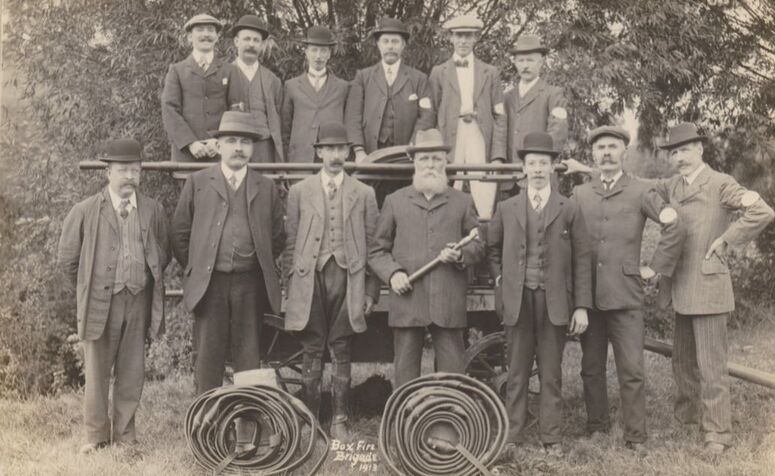Fire Fighters of Box, 1913 Photo courtesy Margaret Wakefield April 2019
Seen left to right, Back Row: C Alexander, H J Norkett, P Vezey, J Stone, F Merrett, A Chaffey;
Front Row: S Sweetland, F Noble, C Merrett, T Merrett, W Crow, J Lawrence, W Sawyer
Front Row: S Sweetland, F Noble, C Merrett, T Merrett, W Crow, J Lawrence, W Sawyer
Thoughts about Fire Fighting
The courage of the French fire fighters in Notre Dame Cathedral was plain for all to see in April 2019 with flames rising hundreds of feet above their heads as they attempted to bring the blaze under control. The Cathedral presented similar sorts of problems to that faced in many buildings in Box with stone walls causing an updraft into wooden roof timbers. The main different between the French firemen and those in Box Fire Brigade before the Second World War was the quality of the equipment used to extinguish fires. Box's manual stirrup-pump hoses and inadequate water pressure meant that village firemen stood very little chance of ever putting out roof fires. Most residential fires had to be left to burn themselves out.
So a different tactic was used in Box in the 1800s and 1900s - that of separating houses from potential sources of fires. It was no coincidence that Vezey's Soap and Candle -making factory was located outside of the main village beyond the area called Townsend. Similarly blacksmith shops were place in more isolated locations - one on the east side of the village at approximately the site of the modern Vine Court, and another at Pye Corner. Both locations were comparatively rural areas before the road infrastructure developed with the new turnpike routes from Corsham into Box (now A4) in 1761 and the Devizes Road in 1841.
It was only at the end of the period of Box's Fire Service that houses were extended into these rural areas , with the inevitable consequence of fires such as that at Browning's Garage in 1931.
The courage of the French fire fighters in Notre Dame Cathedral was plain for all to see in April 2019 with flames rising hundreds of feet above their heads as they attempted to bring the blaze under control. The Cathedral presented similar sorts of problems to that faced in many buildings in Box with stone walls causing an updraft into wooden roof timbers. The main different between the French firemen and those in Box Fire Brigade before the Second World War was the quality of the equipment used to extinguish fires. Box's manual stirrup-pump hoses and inadequate water pressure meant that village firemen stood very little chance of ever putting out roof fires. Most residential fires had to be left to burn themselves out.
So a different tactic was used in Box in the 1800s and 1900s - that of separating houses from potential sources of fires. It was no coincidence that Vezey's Soap and Candle -making factory was located outside of the main village beyond the area called Townsend. Similarly blacksmith shops were place in more isolated locations - one on the east side of the village at approximately the site of the modern Vine Court, and another at Pye Corner. Both locations were comparatively rural areas before the road infrastructure developed with the new turnpike routes from Corsham into Box (now A4) in 1761 and the Devizes Road in 1841.
It was only at the end of the period of Box's Fire Service that houses were extended into these rural areas , with the inevitable consequence of fires such as that at Browning's Garage in 1931.
Box's Firemen
The serving fire fighters in the headline photo hardly seem dressed for action, wearing suits, waistcoats, starched collars and ties and their best Sunday hats. Most of them are middle aged and worthy village residents. Of course, many younger men had joined up for military service at the date of the photograph but this doesn't fully explain why the Box Brigade should have been staffed with solid, middle class men rather than energetic, working class residents. The answer is that, with inadequate equipment, the role of the force was not specifically to put out fires but to safeguard whatever property was left after a blaze. For this, trustworthy citizens were needed, not firefighters. In that sense, the Box fire fighters bore no resemblance to their amazing contemporary French namesakes.
The serving fire fighters in the headline photo hardly seem dressed for action, wearing suits, waistcoats, starched collars and ties and their best Sunday hats. Most of them are middle aged and worthy village residents. Of course, many younger men had joined up for military service at the date of the photograph but this doesn't fully explain why the Box Brigade should have been staffed with solid, middle class men rather than energetic, working class residents. The answer is that, with inadequate equipment, the role of the force was not specifically to put out fires but to safeguard whatever property was left after a blaze. For this, trustworthy citizens were needed, not firefighters. In that sense, the Box fire fighters bore no resemblance to their amazing contemporary French namesakes.
